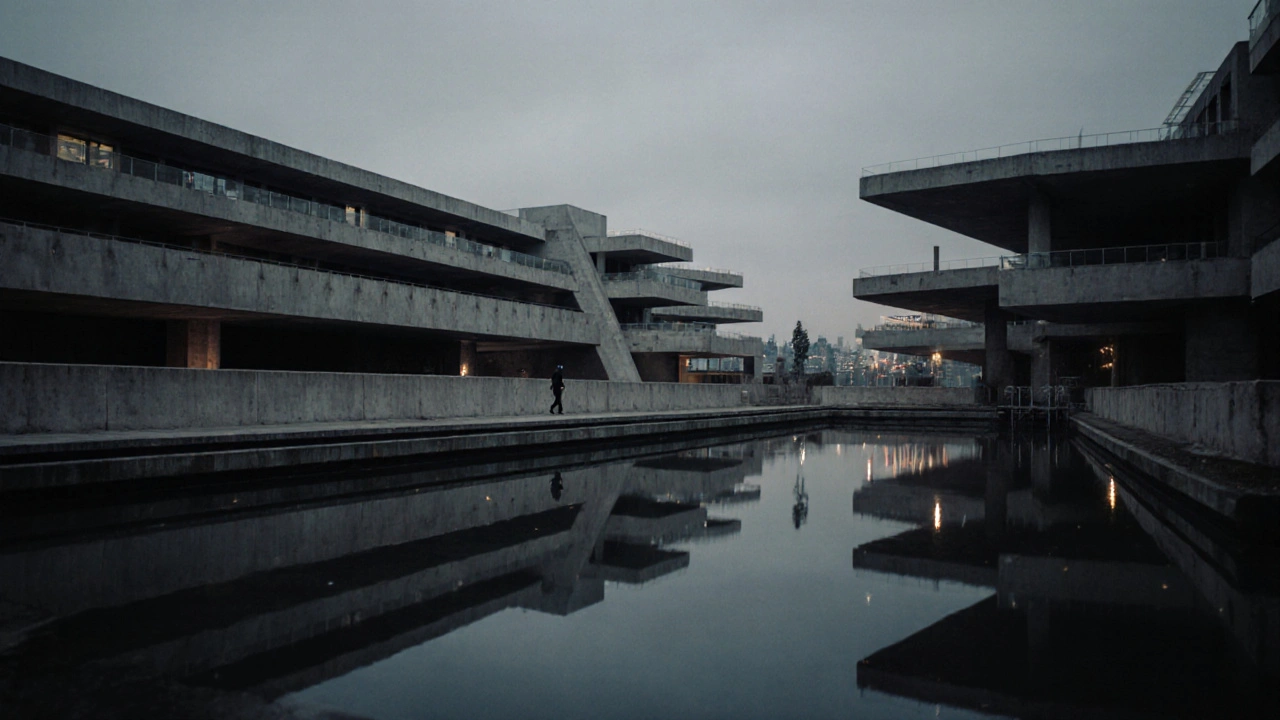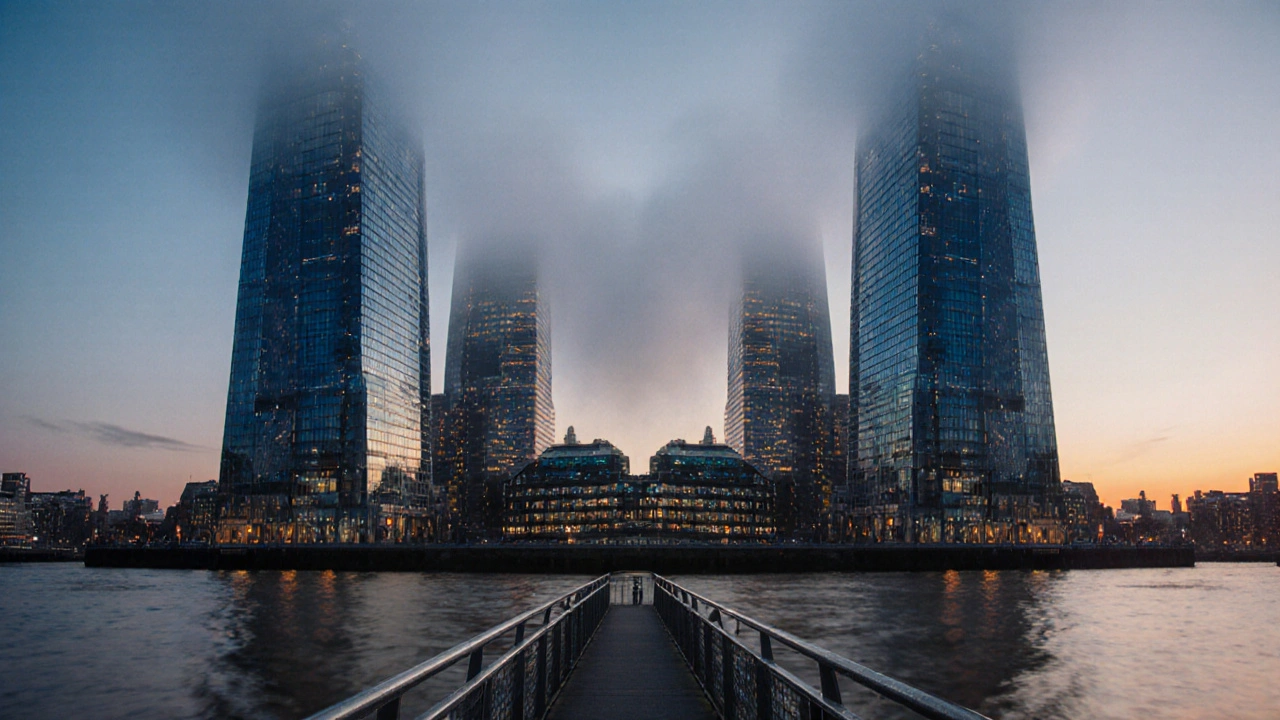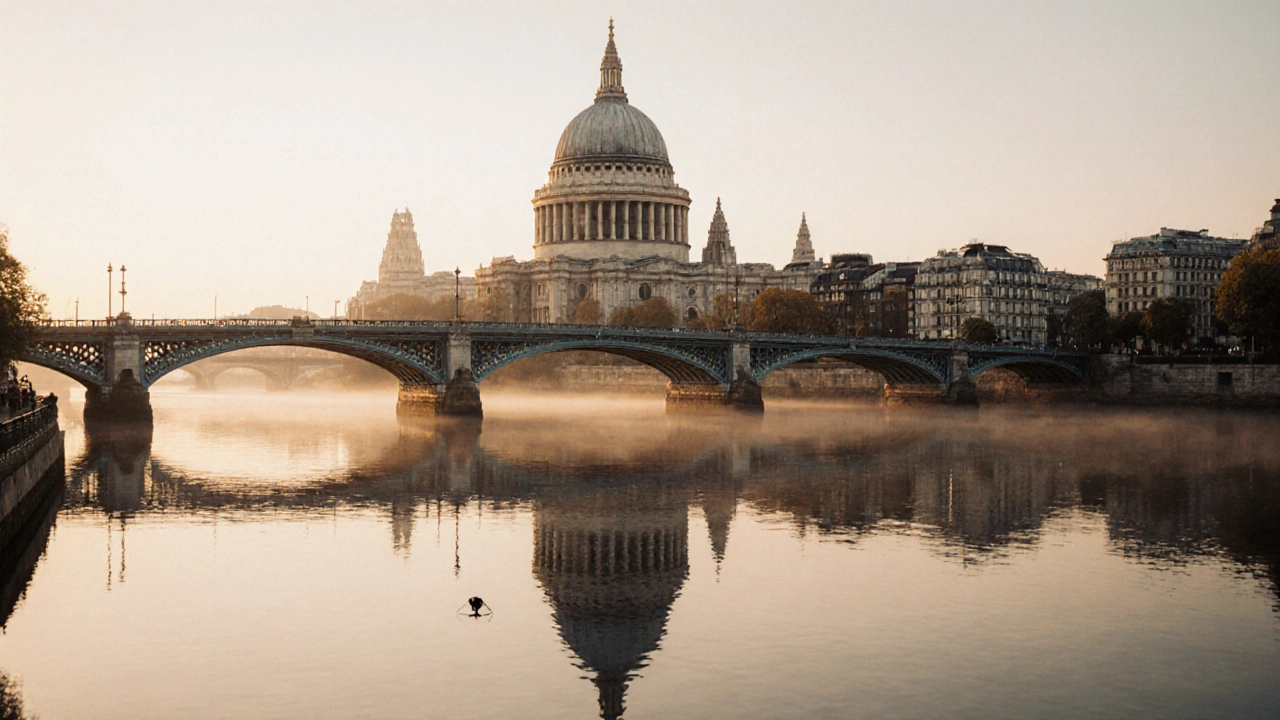London isn’t just a city of history-it’s a living museum of architecture. From medieval stone towers to glass-and-steel giants, every corner offers a new shot waiting to be taken. If you’re carrying a camera, you’re not just visiting London-you’re hunting for composition, light, and structure. The best architectural photography spots here don’t need filters. They need timing, patience, and the right pair of shoes.
St. Paul’s Cathedral and the Millennium Bridge
The view of St. Paul’s from the south bank of the Thames is the postcard you didn’t know you needed. Shoot it at golden hour when the sun hits the dome just right, and the river reflects the whole thing like a mirror. Walk across the Millennium Bridge early in the morning-before the crowds-and you’ll get a clean, uncluttered frame with the cathedral rising behind you. The bridge’s sleek lines act as a natural leading line, pulling the eye straight to the dome. Tripods are allowed here, and you’ll want one. The light changes fast, and you’ll need time to nail the exposure. This spot is where most professional architectural photographers start their London shoot.
The Gherkin (30 St Mary Axe)
Designed by Norman Foster and finished in 2004, The Gherkin isn’t just a building-it’s a sculptural statement. Its curved glass skin reflects the sky and clouds in wild, shifting patterns. The best time to photograph it? Late afternoon, when the western sun glances off its surface and turns it into a glowing orb. Head to the nearby Leadenhall Market or Fenchurch Street for low-angle shots that make the building look like it’s floating. Avoid midday-flat light kills its texture. The Gherkin’s shape plays with perspective like no other skyscraper in London. Shoot from below, shoot from afar, shoot through the trees. It rewards experimentation.
Barbican Estate
Brutalism doesn’t have to be cold. The Barbican Estate, built in the 1960s, is one of the most photographed examples of post-war architecture in Europe. Its elevated walkways, concrete terraces, and mirrored pools create a surreal, almost cinematic feel. Go on a cloudy day. The overcast sky softens the harshness of the concrete and turns the water features into reflective surfaces that double the geometry. The Barbican Centre’s glass facade, with its grid of windows, is perfect for long exposures at dusk. You’ll find photographers here at all hours-some with drones, others with wide-angle lenses. The key is to find the symmetry. Look for repeating patterns in the balconies. Frame a single figure walking along a walkway to show scale. This place feels like a sci-fi set, but it’s real. And it’s open to the public.
London Eye and the South Bank
Yes, the London Eye is a tourist trap. But it’s also one of the most photogenic structures in the city when shot from the right angle. Don’t stand right in front of it. Walk east along the South Bank toward County Hall. From there, you’ll get a clean line of sight with the Eye framed by the river, the Houses of Parliament in the distance, and the red brick of the surrounding buildings. Shoot at sunset, when the sky turns peach and the Eye’s lights come on one by one. Use a slow shutter speed to blur the movement of the capsules-it adds motion without chaos. The South Bank is also lined with historic warehouses turned into galleries and cafes. Their brick facades and arched windows make great foreground elements. This stretch of riverbank is where modern meets old, and the contrast is magnetic.
King’s College London - Strand Campus
Most tourists miss this one. The Strand Campus, with its grand Victorian Gothic facade, looks like it was pulled straight out of a Harry Potter film. The Great Hall, with its vaulted ceiling and stained-glass windows, is a photographer’s dream. The best light comes in through the high windows around 10 a.m. on a clear day. The shadows cast by the stone tracery create intricate patterns on the floor. Outside, the courtyard is framed by columns and arches that lead the eye toward the chapel. Go on a weekday morning-students are in class, and you’ll have the space to yourself. This isn’t a skyline shot. It’s about detail. Focus on the carvings, the ironwork, the way the light dances on the marble. It’s architecture as art.

Canary Wharf - Modern London’s Glass Heart
Just 20 minutes on the Jubilee Line, Canary Wharf is London’s answer to Manhattan. Towering glass skyscrapers like One Canada Square and 25 Bank Street rise like monoliths over the water. The reflections here are insane. Shoot from the Canary Wharf Pier at sunrise. The water acts like a second sky, doubling the buildings and creating perfect symmetry. Foggy mornings? Even better. The mist softens the edges and turns the towers into ghostly silhouettes. Walk along the North Dock and look back toward the skyline. Use a polarizing filter to cut glare and bring out the blue in the glass. This area is less about history and more about power-how architecture shapes identity. It’s cold, clean, and awe-inspiring. Bring a telephoto lens to compress the towers into a single dramatic line.
Victoria Tower Gardens and the Houses of Parliament
Right next to Big Ben, Victoria Tower Gardens is the quietest spot to photograph the Palace of Westminster. Most people stand on the bridge, craning their necks. You’ll get a better shot from the grassy slope near the garden’s eastern end. The angle lets you capture the full height of the Elizabeth Tower with the river curling behind it. The gardens themselves are lined with trees that frame the scene beautifully in autumn. Go when the leaves are turning-red and gold against the Gothic stonework. The light here is soft and forgiving. You can shoot from mid-morning to early evening without harsh shadows. This spot is also great for long exposures at twilight, when the Parliament lights come on and the sky is still blue.
Why These Spots Work
What makes these locations stand out isn’t just their looks-it’s how they respond to light, time, and weather. London’s architecture doesn’t sit still. It changes with the season, the hour, the fog, the rain. The Gherkin looks different on a sunny Tuesday than it does on a misty Thursday. St. Paul’s glows in winter when the sun is low. The Barbican feels eerie in the rain. You don’t need the best camera. You need to be there when the moment happens. That’s the secret.
Pro Tips for Shooting London’s Architecture
- Use a tripod. Even if you’re shooting on a sunny day, slow shutter speeds help capture reflections and motion blur.
- Shoot in RAW. You’ll need the flexibility to recover highlights in glass buildings and shadows in stone.
- Check the weather forecast. Cloud cover is your friend. Overcast days give even light across complex facades.
- Arrive early. The best spots get crowded fast. You’ll have 30 minutes of peace before the tour groups arrive.
- Walk around. The best shot isn’t always the obvious one. Go behind buildings. Look up. Look down. Find the unexpected angle.
- Respect private property. Some buildings have restricted access. Stick to public spaces unless you have permission.

What to Bring
- Wide-angle lens (16-35mm) for interiors and sweeping cityscapes
- Telephoto lens (70-200mm) for compressing skyscrapers and isolating details
- Polarizing filter to reduce glare on glass and water
- Neutral density filter for long exposures at dusk
- Comfortable walking shoes. You’ll be on your feet for hours.
- Power bank. Shooting in RAW drains batteries fast.
When to Go
Spring and autumn are ideal. The light is softer, the crowds are thinner, and the trees add color. Winter gives you crisp, clear skies and long shadows-perfect for geometric shots. Summer is busy and bright, which can wash out details. Avoid midsummer midday-unless you’re going for harsh, high-contrast abstracts.
Final Thought
London’s architecture doesn’t ask for your attention. It demands it. The city doesn’t scream. It whispers-in stone, in glass, in steel. And if you’re quiet enough, patient enough, you’ll hear it through your lens.
What’s the best time of day to photograph London’s architecture?
Golden hour-just after sunrise or before sunset-is ideal. The light is warm, soft, and casts long shadows that highlight texture and depth. For glass buildings like The Gherkin or Canary Wharf, late afternoon light creates stunning reflections. Avoid midday when the sun is directly overhead-it flattens details and creates harsh highlights.
Do I need a tripod for architectural photography in London?
Yes, especially for long exposures at dusk or dawn, or when shooting reflections on water. Many of the best spots-like the Thames at St. Paul’s or Canary Wharf Pier-are windy, so use a sturdy tripod with a weighted hook. Even if you’re using a high ISO, a tripod gives you sharper results and lets you use lower ISO for cleaner images.
Are drones allowed for architectural photography in London?
Drones are heavily restricted in central London. You cannot fly within 5 km of any airport, and most iconic spots-St. Paul’s, the Houses of Parliament, Canary Wharf-are in no-fly zones. Even if you’re on private land, you still need CAA permission. Stick to ground-level shots. The city’s architecture is impressive enough without needing to fly.
Which lens should I use for shooting London’s buildings?
A wide-angle lens (16-35mm) is essential for capturing entire facades, especially in tight urban spaces. For skyscrapers like The Gherkin or Canary Wharf, a telephoto lens (70-200mm) helps compress perspective and isolate details. A 24-70mm zoom is a good all-rounder if you’re traveling light. Don’t forget a polarizing filter-it cuts glare on glass and deepens blue skies.
Can I photograph inside London’s historic buildings?
Most historic buildings allow photography for personal use, but tripods and flash are often banned. Places like St. Paul’s Cathedral and the Houses of Parliament require permission for commercial shoots. Always check signage or ask staff. The Barbican Centre and King’s College London are more relaxed-great for interior shots without hassle.
Are there any free architectural photography spots in London?
Yes. All the spots listed here-St. Paul’s from the south bank, the Barbican, Victoria Tower Gardens, Canary Wharf Pier, and the South Bank-are completely free to access. You don’t need to pay for entry to get world-class shots. The only exception is if you want to go inside a building like St. Paul’s or the London Eye, which charge admission. But you don’t need to go inside to photograph them well.
Next Steps
Grab your camera. Pick one spot. Go at sunrise. Stay for an hour. Watch how the light moves. You don’t need to visit all six locations to capture London’s soul. Just one, shot well, is enough. And when you do, you’ll understand why this city never runs out of stories to tell-through its buildings, its shadows, and its silence.
